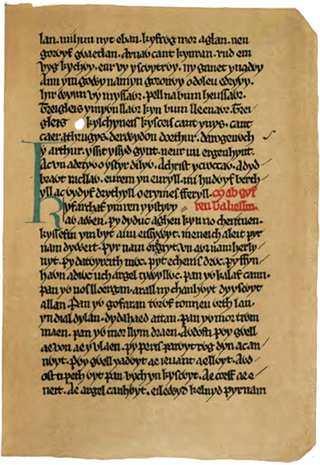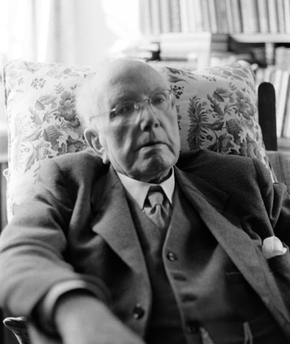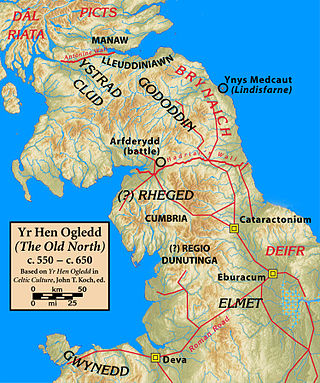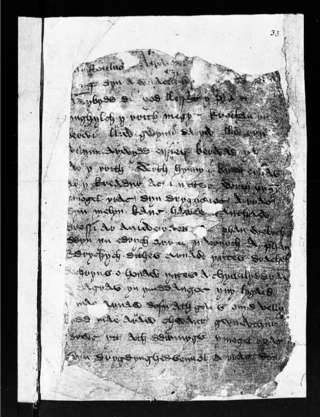
Taliesin was an early Brittonic poet of Sub-Roman Britain whose work has possibly survived in a Middle Welsh manuscript, the Book of Taliesin. Taliesin was a renowned bard who is believed to have sung at the courts of at least three kings.
Aneirin, also rendered as Aneurin or Neirin and Aneurin Gwawdrydd, was an early Medieval Brythonic war poet who lived during the 6th century. He is believed to have been a bard or court poet in one of the Cumbric kingdoms of the Hen Ogledd, probably that of Gododdin at Edinburgh, in modern Scotland. From the 17th century, he was usually known as Aneurin.

The Black Book of Carmarthen is thought to be the earliest surviving manuscript written solely in Welsh. The book dates from the mid-13th century; its name comes from its association with the Priory of St. John the Evangelist and Teulyddog at Carmarthen, and is referred to as black due to the colour of its binding. It is currently part of the collection of the National Library of Wales, where it is catalogued as NLW Peniarth MS 1.

The Book of Taliesin is one of the most famous of Middle Welsh manuscripts, dating from the first half of the 14th century though many of the fifty-six poems it preserves are taken to originate in the 10th century or before.

Y Gododdin is a medieval Welsh poem consisting of a series of elegies to the men of the Brittonic kingdom of Gododdin and its allies who, according to the conventional interpretation, died fighting the Angles of Deira and Bernicia at a place named Catraeth in about AD 600. It is traditionally ascribed to the bard Aneirin and survives only in one manuscript, the "Book of Aneirin".
Medieval Welsh literature is the literature written in the Welsh language during the Middle Ages. This includes material starting from the 5th century AD, when Welsh was in the process of becoming distinct from Common Brittonic, and continuing to the works of the 16th century.

Sir Ifor Williams, was a Welsh scholar who laid the foundations for the academic study of Old Welsh, particularly early Welsh poetry.

Yr Hen Ogledd, meaning the Old North, is the historical region that was inhabited by the Brittonic people of sub-Roman Britain in the Early Middle Ages, now Northern England and the southern Scottish Lowlands, alongside the fellow Brittonic Celtic Kingdom of Elmet, in Yorkshire. Its population spoke a variety of the Brittonic language known as Cumbric which is closely related to, if not a dialect of Old Welsh. The people of Wales and the Hen Ogledd considered themselves to be one people, and both were referred to as Cymry ('fellow-countrymen') from the Brittonic word combrogi. The Hen Ogledd was distinct from the parts of Great Britain inhabited by the Picts, Anglo-Saxons, and Scoti.
Gwallog ap Llênog was possibly a sixth-century ruler of Elfed, a region in the wider area memorialised in later Welsh literature as the 'Old North'. The evidence for Gwallog's existence survives entirely from two poems of spurious date and several other references in semi-legendary genealogies and literature well beyond his era. If this later material is to be believed, he was a member of the Coeling, a family which is supposed to have been prominent across several kingdoms in northern Britain in the sixth century. He is probably best remembered for his role in the Historia Brittonum as an ally of Urien Rheged. As with many figures of this period, he attracted much interest in later Medieval Welsh literature.
The name Edinburgh is used in both English and Scots for the capital of Scotland; in Scottish Gaelic, the city is known as Dùn Èideann. Both names are derived from an older name for the surrounding region, Eidyn. It is generally accepted that this name in turn derives ultimately from the Celtic Common Brittonic language. Eithin is Welsh for "gorse".
The Battle of Catraeth was fought around AD 600 between a force raised by the Gododdin, a Brythonic people of the Hen Ogledd or "Old North" of Britain, and the Angles of Bernicia and Deira. It was evidently an assault by the Gododdin party on the Angle stronghold of Catraeth, perhaps Catterick, North Yorkshire. The Gododdin force was said to have consisted of warriors from all over the Hen Ogledd, and even some from as far afield as Gwynedd in North Wales and Pictland. The battle was disastrous for the Britons, who were nearly all killed. The slain warriors were commemorated in the important early poem Y Gododdin, attributed to Aneirin.
Mynyddog Mwynfawr was, according to Welsh tradition founded on the early Welsh language poem Y Gododdin, a Brittonic ruler of the kingdom of Gododdin in the Hen Ogledd.
Robert Powell Vaughan was an eminent Welsh antiquary and collector of manuscripts. His collection, later known as the Hengwrt–Peniarth Library from the houses in which it was successively preserved, formed the nucleus of the National Library of Wales, and is still in its care.

Welsh-language literature has been produced continuously since the emergence of Welsh from Brythonic as a distinct language in around the 5th century AD. The earliest Welsh literature was poetry, which was extremely intricate in form from its earliest known examples, a tradition sustained today. Poetry was followed by the first British prose literature in the 11th century. Welsh-language literature has repeatedly played a major part in the self-assertion of Wales and its people. It continues to be held in the highest regard, as evidenced by the size and enthusiasm of the audiences attending the annual National Eisteddfod of Wales, probably the largest amateur arts festival in Europe, which crowns the literary prize winners in a dignified ceremony.
Gweith Gwen Ystrat, is a late Old Welsh or Middle Welsh heroic poem found uniquely in the Book of Taliesin, where it forms part of the Canu Taliesin, a series of poems attributed to the 6th-century court poet of Rheged, Taliesin.

Aeron was a kingdom of the Brythonic-speaking Hen Ogledd, presumed to have been located in the region of the River Ayr in what is now southwestern Scotland. It existed during the post-Roman era, perhaps earlier, and disappeared before or during the 7th-century conquest of the region by the ascendant Kingdom of Northumbria.

Eidyn was the region around modern Edinburgh in Britain's sub-Roman and early medieval periods, approximately the 5th–7th centuries. It centred on the stronghold of Din Eidyn, thought to have been at Castle Rock, now the site of Edinburgh Castle, and apparently included much of the area below the Firth of Forth. It was the most important district of the Brittonic kingdom of Gododdin, and a significant power in the Hen Ogledd, or Old North, the Brittonic-speaking area of what is now southern Scotland and northern England.

Peniarth 51, otherwise known as Llyfr Gwilym Tew, is a Welsh manuscript written in the second half of the 15th century. It is mostly in the hand of the bard Gwilym Tew. Although it is known that Gwilym wrote other manuscripts, Peniarth 51 is the only entire manuscript that can be proven to have been his work. It is kept in the National Library of Wales, Aberystwyth, as part of the Peniarth Manuscripts collection.

"Dinogad's Smock" or "Dinogad's Cloak" is an Old Welsh lullaby recounting the hunting prowess of the dead father of an infant named Dinogad, who is wrapped in a smock made of marten skins. This garment gives the poem its modern title.








